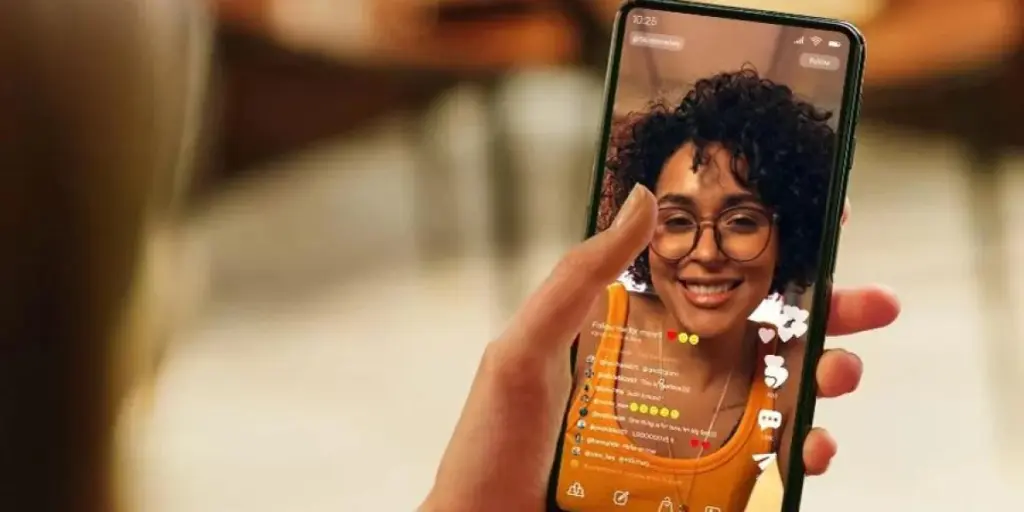An SMS short code or an SMS long code is a phone number people use to send messages, and each one has its advantages and disadvantages.
Long codes seem more personal from the receiver’s end, but they’re more limited in terms of usage.
On the other hand, short codes are an excellent choice for sending bulk messages, but they can get pricey.
Let’s compare the differences in features for SMS long and short codes.
| Features | SMS long codes | SMS short codes |
|---|---|---|
| Messaging type | Application-to-Person or Person-to-Person | Application-to-Person |
| Digits | Up to 10 | 5 to 6 |
| Voice capability | Supported | Not supported |
| Two-way messaging | Yes | Yes |
| Set-up and approval time | 2 to 3 weeks | 2 to 3 months |
| Pricing | Paid per message | Leased per month |
| Throughput | 30 messages per second | 400 messages per second |
| Goals | Providing customer service & one-on-one communication with clients | Sending marketing offers & textual alerts |
Starting with their definition, we’ll compare SMS short code vs long code to help you understand which one fits your marketing needs best.
Table of Contents
What is a long code SMS?
Benefits of long code SMS
What is a short code SMS?
Benefits of short code SMS
Long code vs short code: a quick comparison
When to use a long code SMS
When to use short code SMS
Summary
What is a long code SMS?
A long code SMS is a standard 10-digit number that can be used to send messages, receive calls, and send faxes. It is often used for business purposes, such as customer service, marketing, and in ads. Long code SMS is also used for personal purposes, such as staying in touch with friends and family.
Long code SMS comes in two types, 10-DLC, and SMS-enabled toll-free numbers.
10-DLC or 10-digit long codes support voice and MMS marketing. They use the latest long code technology and are more affordable compared to SMS short codes. However, they do not support read receipts.
The second are the SMS-enabled toll-free numbers. Toll-free numbers are common in businesses and are different from 10-DLCs in that they support read receipts.
Long code numbers are tied to an area code and are typically used in ecommerce marketing for such functions as sending shipping and tracking messages.
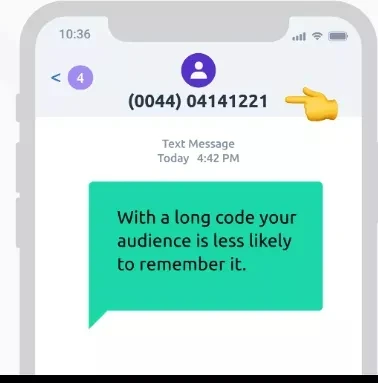
Benefits of long code SMS
Here’s what your business will gain from using SMS long code:
- Increases trust: Long code SMS offers a better personal experience because customers feel like they’re communicating directly with a human being, not a robot. Unlike the automated texts sent via short code, this increases trust.
- Supports two-way texting and voice communication: Long code SMS offers two-way SMS and MMS messaging as well as voice calls. Businesses can send messages and get a response from customers.
- Local appeal: If you run a local company, using a 10-digit SMS code can give you an edge with your local customer base because it has an area code attached to it and consumers are more likely to read a message from their area code.
- Supports voice calls, SMS, and MMS: SMS long codes offer various means of communication including voice calls and faxes.
- A more personalized experience: Long code SMS includes an area code as well as a two-way texting feature. This allows you to send personalized text messages to relevant audiences, including alerts and reminders.
- International reach: Long code SMS supports international text messaging for businesses with a global presence. You can send messages to various countries using your long code virtual number and get responses.
- Easy to set up: Long codes are easy to set up as you can easily convert a landline number into a 10-DCL. With short codes you’d need state and carrier approval, and this takes six to 10 weeks to clear.
What is a short code SMS?
A short code SMS is a 5 or 6-digit number that is used to send a large number of SMS and MMS messages to customers. Customers find short codes easy to recall and type, which makes them an effective way to reach a large audience. They’re a valuable tool for all businesses.
With the help of text messaging software, businesses can send up to 400 messages per second via short codes depending on the provider.
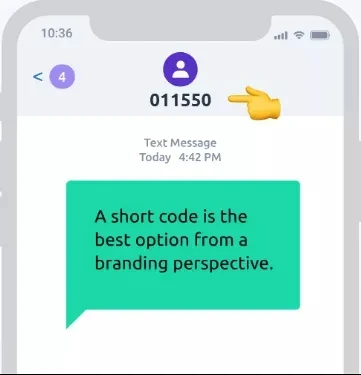
Short code SMS is appropriate for text message marketing for small businesses and medium-sized companies.
There are three types of short code messages:
- Dedicated short codes: These are unique business numbers that allow companies to send unlimited texts for a specific keyword. Dedicated short codes are random and not often remembered by customers.
- Shared short codes: Also known as common-use short codes, SMS marketing shared short codes are used by multiple businesses simultaneously. The SMS service is provided by SMS marketing service providers like Omnisend. The short code is used by their different clients for different keyword triggers.
- Vanity short codes: These are the numbers chosen by businesses that are related to their name or product. For instance, 7-Eleven’s short code is 711711. They’re also used when businesses want a code that customers can easily remember.
Here are a few examples of SMS short codes that popular businesses use:
- Chipotle uses the short code 888-222 for SMS promotions.
- You can reach Facebook for offline notifications via the short code 32665.
- Pizza Hut uses 69488 short code to send promotional messages to clients who opt in.
Benefits of short code SMS
The following are the benefits of SMS short codes that will help you decide whether they’re the best fit for your business.
- Easy to remember: Since they’re short, SMS short codes are relatively easy to remember. For an even more memorable SMS short code, businesses can opt for vanity short codes.
- Sends messages faster: SMS takes the least time to reach your customers compared to other marketing channels. Compared to long codes, short codes have better deliverability and are faster as well.
- Control what goes out: When you have a dedicated short code, you can be in total control of how your SMS campaigns are seen by your customers, which helps you maintain a consistent brand image.
- Allows bulk messaging: SMS Short codes are suitable for businesses that send bulk messages for marketing campaigns. Unlike SMS long codes, which have a lower throughput, SMS short codes let you send up to 400 messages per second.
- Supports two-way messaging: You can use SMS short codes to improve engagement with your consumers. You can send reminders, promotions, and alerts to thousands of users and give them a chance to respond.
- Better for SMS marketing: Given the bulk messaging and memorability aspects, short codes are overall better for SMS marketing campaigns.
Long code vs short code: a quick comparison
The ability to send multiple messages per second is one of the main differences between long code vs short code SMS.
Even though long codes let you send multiple messages, they’re typically designed for person-to-person contact. As such, their throughput rate is lower compared to common short codes.
Short codes can send up to 400 messages per second while long codes can only send up to 30 messages depending on the provider.
Long codes are also more limited, and are typically used for customer support or marketing purposes. Compared to short codes, they’re also harder to track, less secure and less reliable, and are also expensive.
However, short codes are also pricey: they’re leased from the national registry at a fee, for at least three months. You then have to pay for the volume of messages you send using the short code. And vanity SMS short codes are even more expensive to lease, so if you want an easily memorable code it could cost you roughly $500 extra each month.
When to use a long code SMS
SMS long codes are designed for communication and customer service more than they are for marketing. They’re meant to have a more in-person effect on customers for issues such as support, delivery, and other service-related communication.
As such, here are their most common use cases.
- One-on-one communication: Long code SMS is well suited for interpersonal communication with customers both via call and messaging. This means more specific and personal messages as opposed to automated promotional ones.
- For customer service messages: Long code SMS is preferred by most businesses for customer service. They’re more engaging and do not appear automated, which improves their validity and human touch.
- Consistency: Using an SMS long code allows you to have a consistent business phone number across all your marketing channels. This establishes your credibility among your customer base.
- Delivery and tracking updates: Long codes are suited for person-to-person communication, for instance courier services for shipping updates.
Long code SMS can be used to send a medical appointment reminder like the example below:
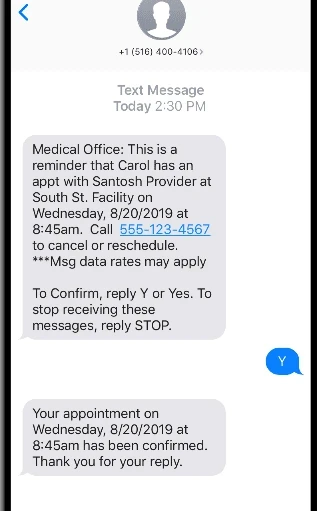
It is also the preferred choice for customer service as shown here:
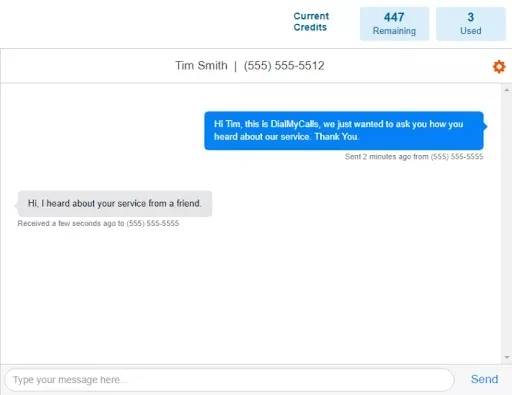
And finally, here’s a delivery update sent with a long code SMS:
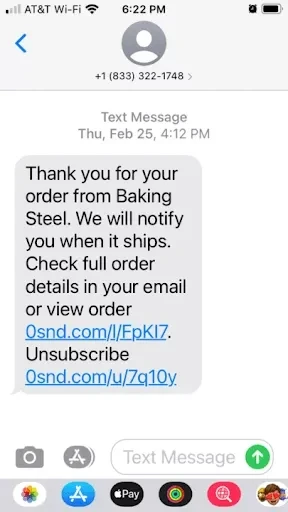
When to use short code SMS
SMS short codes are excellent for mass SMS marketing campaigns and other times you require bulk messaging. Here are some common use cases.
- Running large-scale SMS campaigns: Short codes are excellent for one-way messaging to thousands of customers instantaneously. With their high throughput, they are most suited for marketing purposes. These include SMS mass promotions, automated cart abandonment SMS, and SMS push marketing.
- Running text to win promotions: A simple response to the company’s short code SMS allows customers to enter a contest. For instance, a food chain may prompt you to send a keyword response such as “FREE” to win a shopping voucher.
- Sending product discounts to contacts: Promotional messages can be automated and sent simultaneously to a large volume of contacts without altering their contents. Short codes allow this, but long codes do not.
- Collecting feedback from “text to vote” surveys: Most businesses use short code SMS for their surveys. It’s easy to set up and provides customers with easy response options.
Here’s an example of a Divatress campaign with short code SMS:
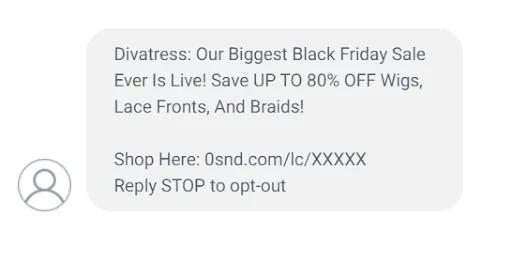
Below is an example of a business collecting feedback with a short code:
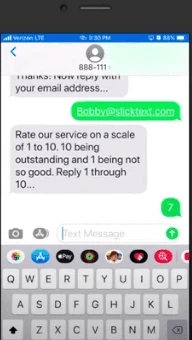
Summary
As you can see, it’s not an SMS long codes vs short codes competition. They each provide different messaging solutions to businesses.
Short codes are best for certain use cases like mass automated SMS marketing campaigns and promotional updates. They are also easier to remember.
On the other hand, long codes are better for personalized communications and customer service. No matter which you choose, you need a good SMS marketing solution.
Source from Omnisend
Disclaimer: The information set forth above is provided by Omnisend independently of Alibaba.com. Alibaba.com makes no representation and warranties as to the quality and reliability of the seller and products.




